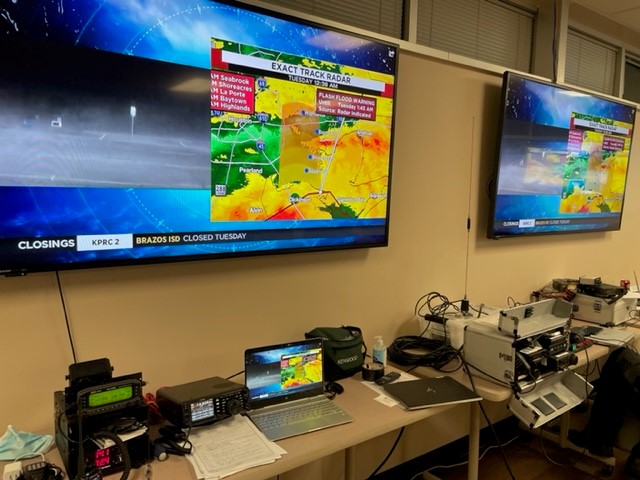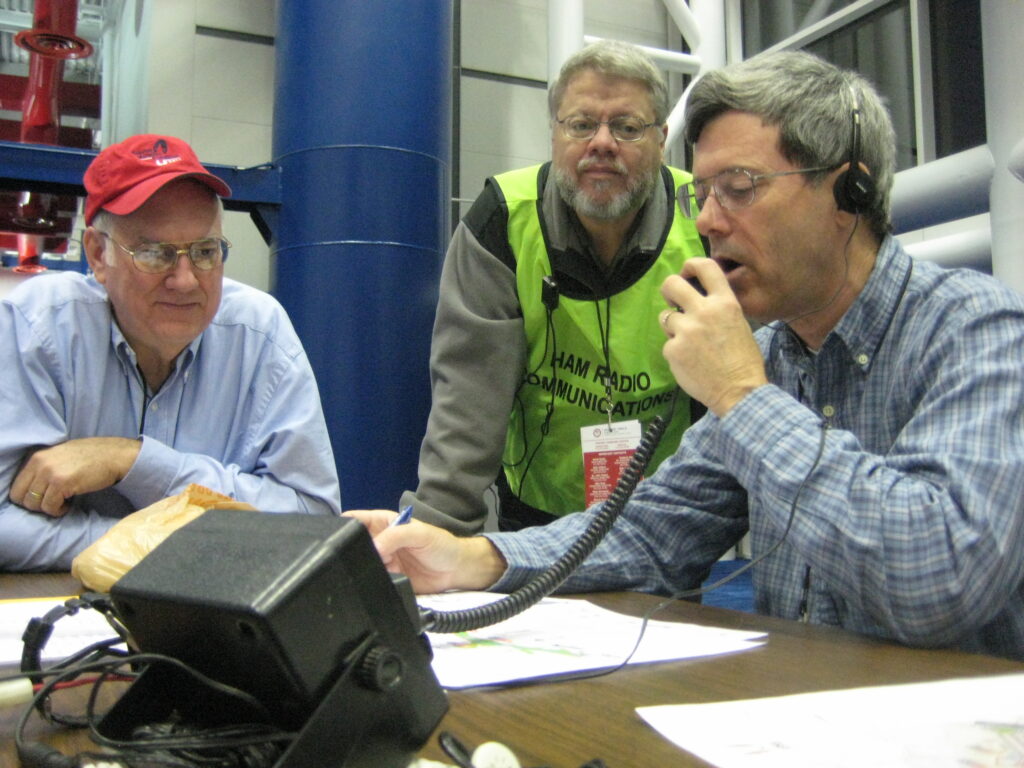Join the team and help serve the community.



To become a member of Harris County ARES and receive a Harris County ARES badge you must;
- Possess a valid amateur radio license
- Possess a sincere desire to serve communications duty in the public service
- Register as a new member with the South Texas ARES Section of the ARRL by filling out this form FSD-98
Membership.
Being a member of ARES offers many different opportunities to develop your skills and learn.
There are three levels of membership based upon individual achievement level.
While not required by the ARRL to be a basic ARES member, many of our served agencies may require you to have taken the FEMA IS-100, IS-200, IS-700, IS-800 incident command courses in order to serve as a communications volunteer. These courses are FREE and only take an hour or two each to complete. Once completed add them to your training records in the STX Info Depot. Because both FEMA and the ARRL keep moving things around on their web-sites links to those are no longer provided. Use your favorite internet search engine and simply put in the course description and you will quickly find it.
It is also highly recommended that you create an account on the Preparing Texas web-site. As you complete any FEMA, DHS, DPS/TDEM, or ARRL training courses the certificates can be uploaded there as well. This gives our served agencies access to your training records. When creating an account use your FCC license in all capital letters and a password you remember.
Basic membership. All that is required to be a basic member is to have an amateur radio license and join ARES.
Intermediate Membership. To be considered an intermediate member once must fullfill the requirements for the Basic membership plus;
- Education
- FEMA IS-100 Course – Introduction to Incident Command System
- FEMA IS-200 Course – Single Resources and Initial Action Incidents
- FEMA IS-700 Course – National Incident Management System (NIMS)
- FEMA IS-800 Course – National Response Framework
- NWS – Skywarn class
- Participation
- Net Participation (once quarterly)
- SET / HURREX or similar drill
- Proficiency / Skill
- Obtain Training Task Book
- Program tone into HT
- Program freq & offset into radio
- Write and send an ICS-213 message
- Operate VHF winlink station
- Setup mobile radio into cross band
- Assemble a 24 hour go-kit
Advanced Membership. To be considered an advanced member once must fullfill the requirements for the Basic & Intermediate membership plus;
- Education
- FEMA IS-802 Course – ESF #2 – Communications
- ARRL EC-001 – Introduction to emergency communication
- Directed net participation
- Public Service Event Once annually
- SET or similar exercise (Bi-Annually)
- Serve as Net Control
- Present a training session
- General Class license or higher
- Proficient in ICS forms
- Operate winlink peer-to-peer
- Assemble powerpoles
- Build simple dipole
Continuing Education
Review the Harris County ARES Operations Manual. It is recommended that you get a 1″ three ring binder and download the STX individual task workbook and the Harris County Operations Manual. Because this is a significant amount of information only download what applies to you. You do not need to download the Com Plans for all four units, just the one you are a member of. Please set some time aside to review the training pages. There is a lot of information here and it may be like trying to drink from a fire hydrant at first but as you check in on nets, listen to others and participate in a few exercises it will all come together for you.
ARRL Courses (fees may be required)
- ARRL EC-001 / Introduction to emergency communication This introductory course provides the basic information you’ll need to participate in ham radio public service and emcomm. This is the equivalent former ARECC Level 1 course.
- ARRL EC-016 / Public Service and Emergency Communications Management – This advanced course has extensive prerequisites and prepares hams to serve in leadership roles for public service. These requirements need to be documented and verified by the ARRL Continuing Education Program office:
- Completion of ARRL’s Level 1 / Basic course, and recommendation from ARRL Section Manager
- FEMA courses that are prerequisites for this course:
- FEMA IS-100 Course Introduction to Incident Command System
- FEMA IS-200 Course Single Resources and Initial Action Incidents
- FEMA IS-700 Course National Incident Management System (NIMS)
- ICS-300, a classroom course, is also highly recommended, but not required.
- FEMA courses that need to be completed prior to the final assessment for this course:
- IS-1 Emergency Manager An Orientation to the Position.
- IS-120 An Introduction to Exercises.
- IS-130 Exercise Evaluation and Improvement Planning.
- IS-139 Exercise Design.
- IS-240 Leadership & Influence
- IS-241 Decision Making and Problem Solving
- IS-244 Developing and Managing Volunteers.
- IS-250 Emergency Support Function 15 (ESF-15) External Affairs.
- IS-288 The Role of Voluntary Agencies in Emergency Management.
- IS-800 National Response Framework
Additional FEMA Courses of interest.
- IS-26 Guide to Points of Distribution.
- IS-242 Effective Communication
- NIMS ICS-400, Advanced Incident Command System
Recommended but not required. This is also a classroom course. - IS-317 Introduction to Community Emergency Response Teams
- IS-802 Emergency Support Functions Communications
Texas RACES
- TX State RACES membership. Contact Sean Ramsey /KG5IRM.
National Weather Service
- NWS Skywarn class
Texas Department of Emergency Management
- TxDEM Has a number of training opportunities
Community Emergency Response Teams
- CERT class completion
American Red Cross
- Red Cross Volunteer Orientation Course and other RC Emergency Preparedness and Disaster Response Training
Practice, Practice, Practice…
Part of the learning process and becoming comfortable with being an emergency communicator is to practice practice practice. Check in to numerous nets. Pretend that you are the net contol station (NCS) and write down all the check ins. Take notes on whatever traffic or training that was passed over the air. When the net is over send the net control station an email with your list of check-ins and notes and ask them to verify that you got it correct. In addition to participating in local V/UHF nets, if you have HF capability, check in to the Texas Traffic net on a regular basis. Even better would be to actually handle traffic on the net.
Another way to improve your skills is to participate in Public Service Events. You will often hear people say that you can not be a good communicator until you are a good listener. A lot of what you will learn doing public service is not what you do but listening to all the traffic handled by the net and how it was handled. Go over in your mind how you might do things slightly differently for yourself. After the event is over talk to the NCS and other communication leaders for the event and discuss things you may have had questions about but over the air during the net was not the appropriate time. Everyone who is in charge of an event or the NCS has started out not knowing much either. Learn from them.
To record your volunteer hours
Notify your EC of any volunteer hours you may work shortly after you work them. Your EC files monthly reports for their units.
